Both my Crumar T1 and T2 “portable” organs (the lower two cases in the stack) came to me without swell (volume) pedals. Each has a rotary potentiometer on its control panel for master volume, but I really want to be able to change the volume dynamically while playing. I’ve been using a Dunlop volume pedal (built into a rocker case identical to the CryBaby wah) on the organ’s output; but (at least when used with the organ) all of the pedal’s action is in about the lower quarter of its physical range, so it’s very finicky to use.
I recently bought this original T1 swell pedal on eBay, listed as untested / project. That usually means tested / didn’t work / can get more money if I don’t admit that I already know it doesn’t work; but I figured I could fix whatever was wrong with it. And I have.
Optical Volume Control
When I plugged the pedal into the organ, the pedal had no effect on the volume, regardless of its position. Opening the pedal, I found this optical volume assembly, with the lamp dark. I measured across the lamp’s leads and got about 14VDC, so power was definitely present and the lamp was definitely burned out. The volume of the organ changed as I exposed the photocell to light and shaded it with my hand; so the connector, cable, and photocell were all still working and the pedal should be easily reparable.
To back up a bit and explain what’s going on, some rocker pedals (Crybaby wahs) use a rack and pinion gear or a string and pulley to turn a rotary potentiometer as the pedal is rocked back and forth. These have the disadvantages of being relatively costly to construct, having the mechanical pot get scratchy as it ages, and being a pain to service.
The Crumar’s swell pedal — and older console organs’ swell pedals, from what I’ve been told — uses a photocell (light-dependent resistor) instead. The pedal’s rocker action moves an opaque tab with a V-shaped notch up and down between a light and the photocell. The width of the part of the notch currently positioned between the lamp and the photocell controls the amount of light falling on the photoresistor, changing its resistance and changing the volume.
It should have been easy to replace the burned-out bulb, but I couldn’t find a part number on it. I could search for a lamp with the same physical form factor, but I have the impression that the same size bulb is available in different power ratings. Without the part number, I wouldn’t know which brightness to buy; and a wrong brightness would change the behavior of the pedal.
LED Replacement
Rather than mess with trying to find the right bulb and risk installing a bulb too bright or dim, I decided to replace it with an LED. I could easily adjust the LED current (hence brightness); and without a filament to burn up, the LED could last even longer than a replacement incandescent bulb.
I started by sanity-checking the photocell so that when I got the LED installed I’d know how well I had done. With the pedal disconnected from power, I got easily 1MΩ resistance with the photocell as dark as I could shade it with my hand while keeping the ohmmeter probes on it, and easily 1kΩ resistance putting it directly under a light.
About this time, I noticed that the V-notch was oriented with its wide end between the light and the photocell when the pedal was rocked back to the minimum volume position. That is, quiet == lots of light == low resistance.
That makes sense. With the pedal not connected, the organ is at full volume. The pedal’s photocell is probably an optional parallel element in the lower half of a volume voltage divider, and lowering its resistance lowers the output voltage.
I grabbed a yellow high-brightness 10mm LED with a far narrower viewing angle than I want to use for anything else (purchased before I started paying attention to the difference between mcd and lumens). It came packed with 470Ω resistors to use in 12VDC applications, and I figured that was close enough to the 14VDC I had measured when it was plugged into the organ.
The original lamp holder wouldn’t really work for the LED, and I may design and print a new one on the CupCake for later. But for now, I used a piece of solid 14-gauge wire as a bracket to get from the mounting screw to the LED, then cheated and doubled that as the ground connection. I added a 1kΩ potentiometer (wired as a variable resistor) in series with the LED’s current-limiting resistor so I could dim it if 22mA turned out to be too bright for the photocell.
Testing
I connected my bench power supply to the connector’s lamp leads and dialed it up to 14V to sanity-test the LED, shown above. I then held the back cover on the case and measured the range of the photocell resistance while rocking the pedal back and forth. In the real dark inside the case, the photocell got up to 7MΩ resistance; with the LED shining through the widest part of the V-notch, it got down to 750Ω resistance. These seemed well in line with what I had tested initially.
I mounted the original lamp assembly to an existing 4mm stud inside the case so a dedicated restorer has the option to put it back to the way it used to be, then closed up the case and went to test with the organ.
I started by setting the pedal to full volume and connecting it to and disconnecting it from the organ. I couldn’t hear any difference in volume with it connected, so it appeared to be set okay on the high end. I then rocked the pedal and got a very nice response curve, giving me smooth control throughout the range of motion, going to not quite silent at the lowest end.
It would be nice to adjust it to go completely quiet — but that would mean lower photocell resistance, requiring more light, requiring more LED current — and it’s already running at 22mA, slightly over its nominal current rating. I’d need to swap to a different LED, or possibly move the LED closer to the notch so the notch intersects the cone of light closer to the apex and allows more light through to the photocell. Then I’d be lowering the photocell resistance below its current minimum of 750Ω, and I’d start wondering whether I needed to inspect the voltage divider and make sure I’m not driving more power through the photocell than I really should.
I’m already delighted with the improvement and I can live with the current behavior. And I can certainly remove the unnecessary potentiometer if I ever have reason to go inside the pedal again.
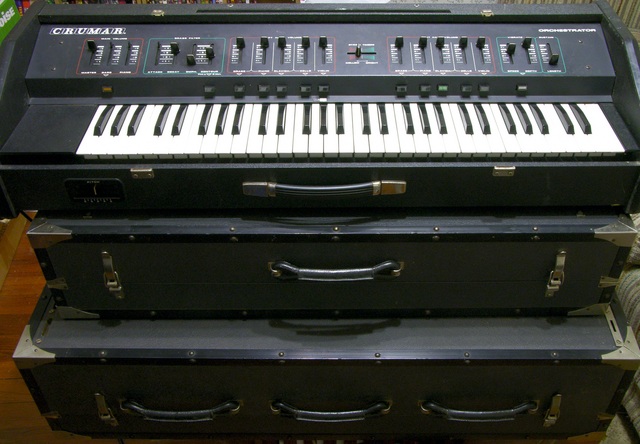
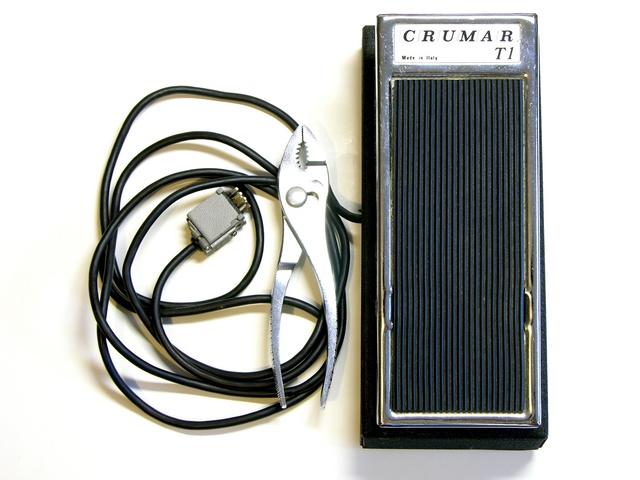
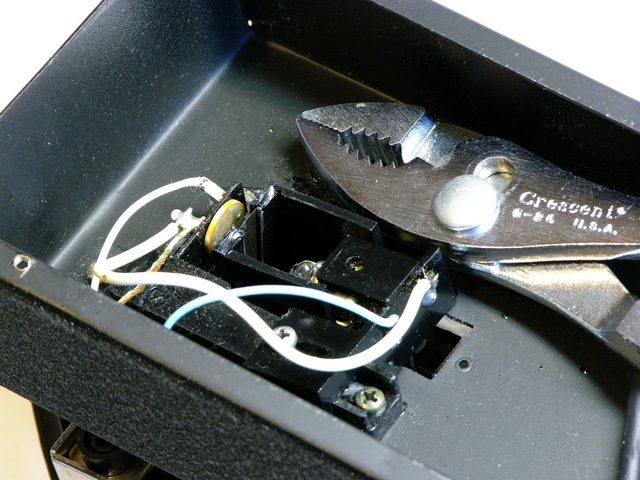
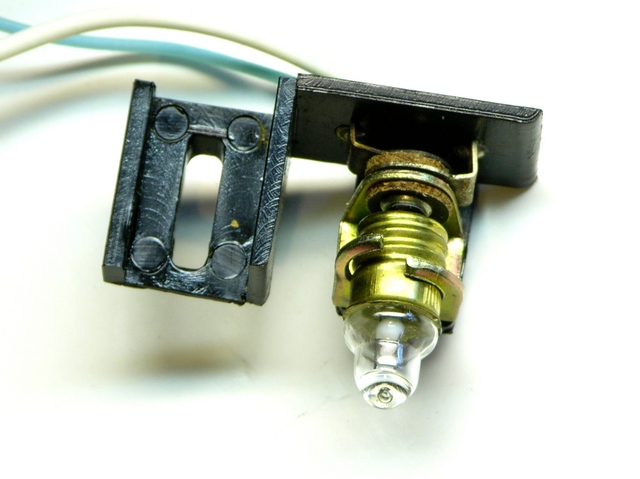

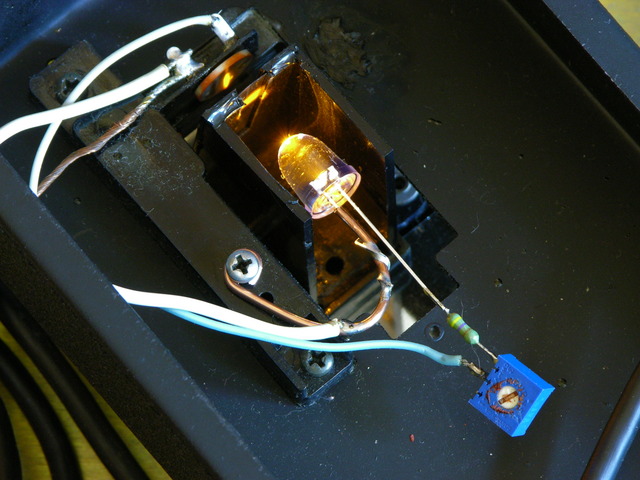
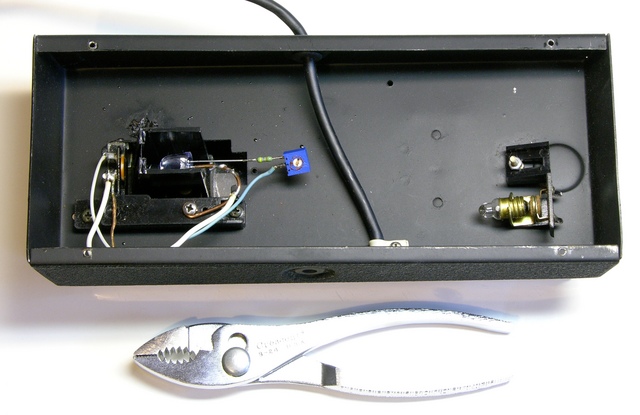
Hi Keith,
An interesting read as I haven’t come across this technique before. I don’t think you can an ever get zero volume though, as it would need the photocell to be a zero resistance. With human hearing being logarithmic you would need to get the resistance very close to zero for it to be below the threshold of hearing.
Chris
Keith,
Perhaps an LED with spectral output that more closely matches the photocell response. Might get you a few less ohms when fully exposed for the same mA.